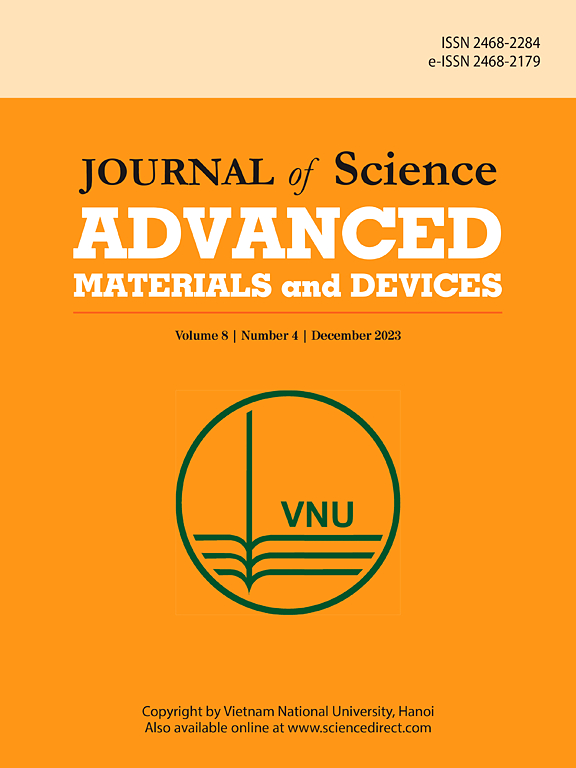Green synthesis of pH-sensitive magnetic bio-nanocomposite hydrogel based on galactomannan and sodium alginate for targeted colorectal cancer drug delivery
IF 6.8
3区 材料科学
Q1 MATERIALS SCIENCE, MULTIDISCIPLINARY
Journal of Science: Advanced Materials and Devices
Pub Date : 2025-04-15
DOI:10.1016/j.jsamd.2025.100892
引用次数: 0
Abstract
This study presents the development and characterization of pH-sensitive bio-nanocomposite hydrogel beads designed for the targeted delivery of doxorubicin (DOX) in colorectal cancer (CRC) therapy. The hydrogels were synthesized using galactomannan (GM) and sodium alginate (SA) matrices, reinforced with Fe3O4 magnetic nanoparticles (MNPs) to enhance drug release control and therapeutic efficacy. The MNPs were functionalized through a green synthesis approach, utilizing copper oxide nanoparticles (CuO NPs) reduced and stabilized by orange peel extract (OPE) and carbon quantum dots (CQDs) derived from tea leaves. Characterization techniques (FTIR, XRD, SEM, VSM, PL) confirmed the successful synthesis of the carrier components. In vitro drug release studies demonstrated pronounced pH-sensitive behavior, with minimal release (<14 %) observed at pH 1.2 and substantial release (>88 %) at pH 7.4, indicating potential for targeted delivery to the colorectal region. The carrier exhibited significant antioxidant and antibacterial activity effects against Gram-negative Escherichia coli (>94 % inhibition) and Gram-positive Staphylococcus aureus (>99 % inhibition). Moreover, MTT assays revealed significant cytotoxicity effects of drug-loaded carriers against HT-29 CRC cells. These findings showed the promising potential of synthesized materials for targeted CRC therapy, offering a synergistic combination of controlled drug release, antioxidant properties, and antibacterial activity.
基于半乳甘露聚糖和海藻酸钠的ph敏感磁性生物纳米复合水凝胶的绿色合成用于结直肠癌靶向给药
本研究介绍了用于在结直肠癌(CRC)治疗中靶向递送多柔比星(DOX)的 pH 敏感性生物纳米复合水凝胶珠的开发和表征。这种水凝胶是用半乳甘露聚糖(GM)和海藻酸钠(SA)基质合成的,并用Fe3O4磁性纳米粒子(MNPs)增强,以提高药物释放控制和疗效。MNPs 通过绿色合成方法进行功能化,利用橙皮提取物(OPE)还原和稳定的氧化铜纳米颗粒(CuO NPs)以及从茶叶中提取的碳量子点(CQDs)。表征技术(傅立叶变换红外光谱、X 射线衍射、扫描电镜、可见分光光度计、聚光光度计)证实了载体成分的成功合成。体外药物释放研究表明,该载体具有明显的 pH 值敏感性,在 pH 值为 1.2 时,药物释放量极小(14%),而在 pH 值为 7.4 时,药物释放量很大(88%),这表明该载体具有向结肠直肠部位靶向给药的潜力。该载体对革兰氏阴性大肠杆菌(抑制率达 94%)和革兰氏阳性金黄色葡萄球菌(抑制率达 99%)具有明显的抗氧化和抗菌活性。此外,MTT 试验显示药物载体对 HT-29 CRC 细胞具有显著的细胞毒性作用。这些研究结果表明,合成材料具有药物控释、抗氧化性和抗菌活性的协同组合,有望用于靶向治疗 CRC。
本文章由计算机程序翻译,如有差异,请以英文原文为准。
求助全文
约1分钟内获得全文
求助全文
来源期刊

Journal of Science: Advanced Materials and Devices
Materials Science-Electronic, Optical and Magnetic Materials
CiteScore
11.90
自引率
2.50%
发文量
88
审稿时长
47 days
期刊介绍:
In 1985, the Journal of Science was founded as a platform for publishing national and international research papers across various disciplines, including natural sciences, technology, social sciences, and humanities. Over the years, the journal has experienced remarkable growth in terms of quality, size, and scope. Today, it encompasses a diverse range of publications dedicated to academic research.
Considering the rapid expansion of materials science, we are pleased to introduce the Journal of Science: Advanced Materials and Devices. This new addition to our journal series offers researchers an exciting opportunity to publish their work on all aspects of materials science and technology within the esteemed Journal of Science.
With this development, we aim to revolutionize the way research in materials science is expressed and organized, further strengthening our commitment to promoting outstanding research across various scientific and technological fields.
 求助内容:
求助内容: 应助结果提醒方式:
应助结果提醒方式:


